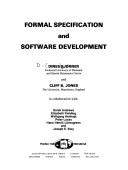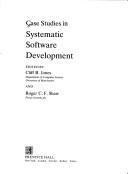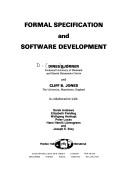| Listing 1 - 10 of 32 | << page >> |
Sort by
|
Book
Year: 1947 Publisher: Willesden Cliff Jones
Abstract | Keywords | Export | Availability | Bookmark
 Loading...
Loading...Choose an application
- Reference Manager
- EndNote
- RefWorks (Direct export to RefWorks)
Book
Year: 1947 Publisher: Willesden Cliff Jones
Abstract | Keywords | Export | Availability | Bookmark
 Loading...
Loading...Choose an application
- Reference Manager
- EndNote
- RefWorks (Direct export to RefWorks)
Book
ISBN: 354019651X 038719651X 1447131800 9783540196518 Year: 1991 Publisher: London: Springer,
Abstract | Keywords | Export | Availability | Bookmark
 Loading...
Loading...Choose an application
- Reference Manager
- EndNote
- RefWorks (Direct export to RefWorks)
Programming --- Computer software --- Development --- Mural (Computer file) --- Development. --- Mural (Computer file). --- Computer software - Development

ISBN: 0138218846 9780138218843 Year: 1980 Publisher: Englewood Cliffs: Prentice Hall,
Abstract | Keywords | Export | Availability | Bookmark
 Loading...
Loading...Choose an application
- Reference Manager
- EndNote
- RefWorks (Direct export to RefWorks)
Programming --- Computer software --- Logiciels --- Development --- Développement --- Computer programming --- -681.3*D21 --- 681.3*D22 --- 681.3*D24 --- Software, Computer --- Computer systems --- Requirements/specifications: languages; methodologies; tools (Software engineering)--See also {681.3*D31} --- Tools and techniques: decision tables; flow charts; modules and interfaces; programmer workbench; software libraries; structured programming; top-down programming; user interfaces (Software engineering) --- Program verification: assertion checkers; correctness proofs; reliability; validation (Software engineering)--See also {681.3*F31} --- Programmeren: software --- Development. --- Programmeren: software. --- 681.3*D24 Program verification: assertion checkers; correctness proofs; reliability; validation (Software engineering)--See also {681.3*F31} --- 681.3*D22 Tools and techniques: decision tables; flow charts; modules and interfaces; programmer workbench; software libraries; structured programming; top-down programming; user interfaces (Software engineering) --- 681.3*D21 Requirements/specifications: languages; methodologies; tools (Software engineering)--See also {681.3*D31} --- 681.3*D21 --- Development of computer software --- Software development --- Computer software - Development --- Data Type --- Algorithm --- Program Theory --- proof

ISBN: 0131160885 9780131160880 Year: 1990 Publisher: New York: Prentice Hall,
Abstract | Keywords | Export | Availability | Bookmark
 Loading...
Loading...Choose an application
- Reference Manager
- EndNote
- RefWorks (Direct export to RefWorks)
Computer software --- -681.3*D2 --- Software, Computer --- Computer systems --- Development --- -Case studies --- Software engineering: protection mechanisms; standards--See also {681.3*K63}; {681.3*K51} --- 681.3*D2 Software engineering: protection mechanisms; standards--See also {681.3*K63}; {681.3*K51} --- 681.3*D2 --- Development&delete& --- Case studies --- Relational Databases --- Case Studies --- proof --- Unification --- Garbage Collection --- Vdm
Book
ISBN: 303059257X 3030592561 Year: 2020 Publisher: Cham, Switzerland : Springer,
Abstract | Keywords | Export | Availability | Bookmark
 Loading...
Loading...Choose an application
- Reference Manager
- EndNote
- RefWorks (Direct export to RefWorks)
This book is about describing the meaning of programming languages. The author teaches the skill of writing semantic descriptions as an efficient way to understand the features of a language. While a compiler or an interpreter offers a form of formal description of a language, it is not something that can be used as a basis for reasoning about that language nor can it serve as a definition of a programming language itself since this must allow a range of implementations. By writing a formal semantics of a language a designer can yield a far shorter description and tease out, analyse and record design choices. Early in the book the author introduces a simple notation, a meta-language, used to record descriptions of the semantics of languages. In a practical approach, he considers dozens of issues that arise in current programming languages and the key techniques that must be mastered in order to write the required formal semantic descriptions. The book concludes with a discussion of the eight key challenges: delimiting a language (concrete representation), delimiting the abstract content of a language, recording semantics (deterministic languages), operational semantics (non-determinism), context dependency, modelling sharing, modelling concurrency, and modelling exits. The content is class-tested and suitable for final-year undergraduate and postgraduate courses. It is also suitable for any designer who wants to understand languages at a deep level. Most chapters offer projects, some of these quite advanced exercises that ask for complete descriptions of languages, and the book is supported throughout with pointers to further reading and resources. As a prerequisite the reader should know at least one imperative high-level language and have some knowledge of discrete mathematics notation for logic and set theory.
Computers. --- Computer software. --- Software engineering. --- Theory of Computation. --- Professional Computing. --- Software Engineering/Programming and Operating Systems. --- Computer software engineering --- Engineering --- Software, Computer --- Computer systems --- Automatic computers --- Automatic data processors --- Computer hardware --- Computing machines (Computers) --- Electronic brains --- Electronic calculating-machines --- Electronic computers --- Hardware, Computer --- Cybernetics --- Machine theory --- Calculators --- Cyberspace --- Programming languages (Electronic computers) --- Computer programming. --- Computers --- Electronic computer programming --- Electronic data processing --- Electronic digital computers --- Programming (Electronic computers) --- Coding theory --- Computer languages --- Computer program languages --- Computer programming languages --- Machine language --- Languages, Artificial --- Programming
Digital
ISBN: 9783030592578 Year: 2020 Publisher: Cham Springer International Publishing
Abstract | Keywords | Export | Availability | Bookmark
 Loading...
Loading...Choose an application
- Reference Manager
- EndNote
- RefWorks (Direct export to RefWorks)
This book is about describing the meaning of programming languages. The author teaches the skill of writing semantic descriptions as an efficient way to understand the features of a language. While a compiler or an interpreter offers a form of formal description of a language, it is not something that can be used as a basis for reasoning about that language nor can it serve as a definition of a programming language itself since this must allow a range of implementations. By writing a formal semantics of a language a designer can yield a far shorter description and tease out, analyse and record design choices. Early in the book the author introduces a simple notation, a meta-language, used to record descriptions of the semantics of languages. In a practical approach, he considers dozens of issues that arise in current programming languages and the key techniques that must be mastered in order to write the required formal semantic descriptions. The book concludes with a discussion of the eight key challenges: delimiting a language (concrete representation), delimiting the abstract content of a language, recording semantics (deterministic languages), operational semantics (non-determinism), context dependency, modelling sharing, modelling concurrency, and modelling exits. The content is class-tested and suitable for final-year undergraduate and postgraduate courses. It is also suitable for any designer who wants to understand languages at a deep level. Most chapters offer projects, some of these quite advanced exercises that ask for complete descriptions of languages, and the book is supported throughout with pointers to further reading and resources. As a prerequisite the reader should know at least one imperative high-level language and have some knowledge of discrete mathematics notation for logic and set theory.
Computer architecture. Operating systems --- Computer. Automation --- bedrijfssoftware --- computers --- software engineering

ISBN: 0133290034 9780133290035 Year: 1982 Publisher: Englewood Cliffs: Prentice Hall,
Abstract | Keywords | Export | Availability | Bookmark
 Loading...
Loading...Choose an application
- Reference Manager
- EndNote
- RefWorks (Direct export to RefWorks)
Programming --- Computer software --- Programming languages (Electronic computers) --- Development --- -Programming languages (Electronic computers) --- 681.3*D0 --- 681.3*D2 --- 681.3*D21 --- 681.3*F4 --- Computer languages --- Computer program languages --- Computer programming languages --- Machine language --- Electronic data processing --- Languages, Artificial --- Software, Computer --- Computer systems --- Computerwetenschap--?*D0 --- Software engineering: protection mechanisms; standards--See also {681.3*K63}; {681.3*K51} --- Requirements/specifications: languages; methodologies; tools (Software engineering)--See also {681.3*D31} --- Mathematical logic and formal languages (Theory of computation) --- Programming languages (Electronic computers). --- Development. --- 681.3*F4 Mathematical logic and formal languages (Theory of computation) --- 681.3*D21 Requirements/specifications: languages; methodologies; tools (Software engineering)--See also {681.3*D31} --- 681.3*D2 Software engineering: protection mechanisms; standards--See also {681.3*K63}; {681.3*K51} --- Development of computer software --- Software development --- Computer software - Development
Book
ISBN: 331906410X 3319064096 Year: 2014 Publisher: Cham : Springer International Publishing : Imprint: Springer,
Abstract | Keywords | Export | Availability | Bookmark
 Loading...
Loading...Choose an application
- Reference Manager
- EndNote
- RefWorks (Direct export to RefWorks)
This book constitutes the refereed proceedings of the 19th International Symposium on Formal Methods, FM 2014, held in Singapore, May 2014. The 45 papers presented together with 3 invited talks were carefully reviewed and selected from 150 submissions. The focus of the papers is on the following topics: Interdisciplinary Formal Methods, Practical Applications of Formal Methods in Industrial and Research Settings, Experimental Validation of Tools and Methods as well as Construction and Evolution of Formal Methods Tools.
Formal methods (Computer science) --- Software engineering. --- Computer science. --- Logic design. --- Information Systems. --- Software Engineering. --- Mathematical Logic and Formal Languages. --- Logics and Meanings of Programs. --- Management of Computing and Information Systems. --- Computation by Abstract Devices. --- Design, Logic --- Design of logic systems --- Digital electronics --- Electronic circuit design --- Logic circuits --- Machine theory --- Switching theory --- Informatics --- Science --- Computer software engineering --- Engineering --- Mathematical logic. --- Computer logic. --- Management information systems. --- Computers. --- Automatic computers --- Automatic data processors --- Computer hardware --- Computing machines (Computers) --- Electronic brains --- Electronic calculating-machines --- Electronic computers --- Hardware, Computer --- Computer systems --- Cybernetics --- Calculators --- Cyberspace --- Computer-based information systems --- EIS (Information systems) --- Executive information systems --- MIS (Information systems) --- Sociotechnical systems --- Information resources management --- Management --- Computer science logic --- Logic, Symbolic and mathematical --- Algebra of logic --- Logic, Universal --- Mathematical logic --- Symbolic and mathematical logic --- Symbolic logic --- Mathematics --- Algebra, Abstract --- Metamathematics --- Set theory --- Syllogism --- Communication systems
Book
ISBN: 3642245404 3642245412 Year: 2011 Publisher: Berlin, Heidelberg : Springer Berlin Heidelberg : Imprint: Springer,
Abstract | Keywords | Export | Availability | Bookmark
 Loading...
Loading...Choose an application
- Reference Manager
- EndNote
- RefWorks (Direct export to RefWorks)
This Festschrift volume, published in honor of Brian Randell on the occasion of his 75th birthday, contains a total of 37 refereed contributions. Two biographical papers are followed by the six invited papers that were presented at the conference 'Dependable and Historic Computing: The Randell Tales', held during April 7-8, 2011 at Newcastle University, UK. The remaining contributions are authored by former scientific colleagues of Brian Randell. The papers focus on the core of Brian Randell’s work: the development of computing science and the study of its history. Moreover, his wider interests are reflected and so the collection comprises papers on software engineering, storage fragmentation, computer architecture, programming languages and dependability. There is even a paper that echoes Randell’s love of maps. After an early career with English Electric and then with IBM in New York and California, Brian Randell joined Newcastle University. His main research has been on dependable computing in all its forms, especially reliability, safety and security aspects, and he has led several major European collaborative projects.
Engineering & Applied Sciences --- Computer Science --- Computer science. --- Microprogramming. --- Software engineering. --- Programming languages (Electronic computers). --- Operating systems (Computers). --- Computer security. --- Computers. --- Computer Science. --- History of Computing. --- Operating Systems. --- Systems and Data Security. --- Control Structures and Microprogramming. --- Software Engineering. --- Programming Languages, Compilers, Interpreters. --- Automatic computers --- Automatic data processors --- Computer hardware --- Computing machines (Computers) --- Electronic brains --- Electronic calculating-machines --- Electronic computers --- Hardware, Computer --- Computer systems --- Cybernetics --- Machine theory --- Calculators --- Cyberspace --- Computer privacy --- Computer system security --- Computers --- Cyber security --- Cybersecurity --- Electronic digital computers --- Protection of computer systems --- Security of computer systems --- Data protection --- Security systems --- Hacking --- Computer operating systems --- Disk operating systems --- Systems software --- Computer languages --- Computer program languages --- Computer programming languages --- Machine language --- Electronic data processing --- Languages, Artificial --- Computer software engineering --- Engineering --- Computer programming --- Informatics --- Science --- Protection --- Security measures --- Operating systems --- Microprogramming . --- Operating systems (Computers) --- Data protection. --- Computers—History. --- Compilers (Computer programs). --- Data and Information Security. --- Compilers and Interpreters. --- Compiling programs (Computer programs) --- Computer programs --- Programming software --- Data governance --- Data regulation --- Personal data protection --- Protection, Data
| Listing 1 - 10 of 32 | << page >> |
Sort by
|

 Search
Search Feedback
Feedback About UniCat
About UniCat  Help
Help News
News